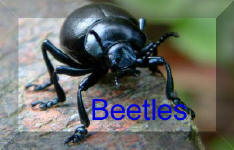Back To

Size:Length 8-9 mm
Head, pronotum and scutellum black, coarsely punctate with small white scales although along the base of the pronotum some are blue as are the underside scales. Antennae, head in front of eyes and lateral margins of pronotum with stout setae. Front margin of clypeus strongly raised. Pronotum widest at middle, narrowed anteriorly and posteriorly, hind margin strongly sinuate. Elytra quadrate, shining red or variously darkened, depressed inside humeral prominences and with white scales often patchily arranged. Pygidium and propygidium exposed. Legs stout; protibiae with 3 prominent teeth on outer side, meso and metatibiae with short spines throughout. Femora and tibiae with sparse blue scaling among the orange spines. Tarsi 5-5-5, segments 1-4 ringed with very short spines apically, last segment long and incurved. Pro and mesotarsi with 2 incurved claws, the outer about half the length of the inner, all longitudinally divided at tip. Hind tarsus with a single long incurved claw longitudinally divided at tip, this character separates Hoplia from all other British scaraboidea. Antennae and legs black in male, red in female
Distribution:
Found throughout the UK, but are more common in the south.
Months Active: The adult beetle can be seen from June to August. The beetles are active during the day, particularly in June and early July when they seeking a mate.typically emerge around mid-June and males swarm over herbage or grass searching for females. Eggs are laid in the ground in midsummer and larvae feed on roots in the autumn and spring before pupating in earthen cells in late spring. The life cycle is completed in a single year
Habitat: It is usually seen in meadows and along hedgerows and woodland edges.
Features: Its larvae feed on a wide range of plant species, including grass roots, and can be a problem in sports turf and lawns.



